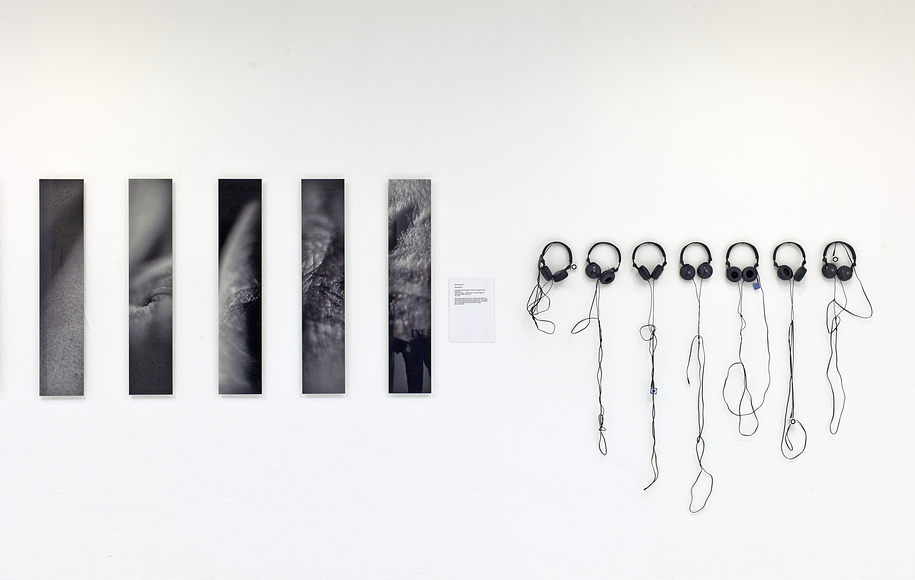Installation “B.O.D.Y.” consists of photography and sound (sonic and music) composition of and for different people, nationalities, gender and age groups, as well as a part of myself.
My audiovisual concept on the subject of the body comprises both feelings of closeness and distance.
I try to create a virtual world of sensitive touch which interacts with the shared senses of others.
B.O.D.Y. - 7 x Sound (electro-acoustic Sound)
Thank you for UNI-K, UdK Berlin under the direction of Prof. Dr Supper Martin, Sound Studio, Niklas Schmincke, Studio P4, Funkhaus, Berlin, 2010.
A new sound system is planned for the future presentation. The original compositional concept is retained.
Digitalization and Digital humanity in artistic formalism, Erika Matsunami:
I explored B.O.D.Y. (2010) between 2000–2010 before starting academic discourse on digital humanities.
This installation is the conclusion of my exploration 10 years long. (...)
My question at that time was, how can technology shape and formalise a person's history and life as well as personality?
One is DNA, as a blueprint of a person. It is eternity and our life, that will be protected in the environment, but how it will be protected?
It gives us a new consideration of identity. If it works in a positive way, which does not belong in capitalism. It will maybe lose racism, sexism as well as gender difference and their conflict in society. In the economic system, it should be transcendency. If it won't transcendency and anarchy, then it will maybe start the dictatorship again, such as in the modern imperialism era.
Perhaps, in the 22nd century, 100 years from now, our thoughts about something will be completely different.
In 2022, after B.O.D.Y., my recent artistic research and project Stillleben/Still life address biology and ecology (life science) towards posthumanism from the critical aspect, it started artistic research and project a.o.i. - lasting memories in Winter 2021. (in other words, not digital humanities, but rather life science should be advanced more than digital humanities, that is my way of artistic research.)
(In 2022, I started to work on B.O.D.Y. for the catalogue.)
My artistic practice in sculpture is 'relief' of its spatiality and narrativity in connection with materiality rather than as the symbolism in the post-conceptual era. It is something, MA (間) as a transmedia between Relief and Byōbu.
On minority and majority in a society
When extreme categorization occurs in society, by which norm of
----
Extreme categorization is a “one and only” category with no overlapped. In Germany, it calls 'pure' - unmixed
Take for example the dark gallery in Copenhagen where will be represented my artwork in photography; only analogue photography, but it is in the sense of large scale (kind), and it does not mean the photographic category by Dark gallery.
The final artwork in analogue photography must be Silver Gelatine Prints (not prints art, only in photography) for the gallery collection. For the representation, I can do everything, but it must be in photography. They are not dogmatic, and rather unconventional. Thereby, the artistic approach is possible to create very widely. – a narrow focusing on the subject
(Artwork is a contribution, not a commodity. But it is possible to produce goods from the artwork.)
Their concept is based epistemologically and in terms of anti-realism such as danish philosophy in humanities and arts. In Germany, it would be rather comprehended in the context of Kant, and many others.
-> Thereby, my suggestion for this question, one is the exploration of the methodological manner./Dabei ist mein Vorschlag für diese Fragestellung die Erforschung der methodischen Vorgehensweise.
That is the artistic approach on and towards subject.
Nanay's approach "Distributed attention" in Aesthetics as Philosophy of Perception, Bence Nanay, OUP 2016
'Uniqueness' as the aesthetic domain in terms of Kant's theory of judgment is also the same as the relationship of X and Y, changing together with our knowledge and awareness.
I see the artistic approach as a domain of aesthetic value more than from the aesthetic experience through seeing the side.
Ich verstehe die künstlerische Herangehensweise eher als eine Domäne von ästhetischem Wert als von der ästhetischen Erfahrung durch das Sehen, sowie Ereleben her. Ich begreife als "Ereignis" eher gelegentliche "ästhetische Erfahrung". (Grasping Kant from an Outside Perspective of German Idealism.)
Towards “Chapter 6. Uniqueness“, Aesthetics as Philosophy of Perception, Bence Nanay, OUP 2016, pp. 117–127
On aesthetic vandality and queer
- Autonomy in love
Homosexuality is legally recognized and protected in Western industrialized countries.
freedom of love, without discrimination of gender difference, and of race.
But even there the pitfalls of capitalism intersect more complicated than in a classic love affairs (platonic love).
Will the digital humanities change the family structure in society? (Are human rights thoroughly protected?)
On Love in two female disability performers who were sitting in the wheelchair – sensory love
From platonic love to sensory love in two female disability performers who were sitting in the wheelchair. Love in this extremely limited situation, not in general terms.
https://www.art-identityem.com/kopie-von-writing
-> Momentanaufnahme /snapshot and distributed attention -> from a static image to a new aesthetic experience
Analogue photography as a new fashion
After Camera Lucida: Reflections on photography, Roland Barthes, 1980, in the 21st century.
That is an aim of the exhibition SKIN with three different types of the wrok by the anaolgue photography and its individual representation in the exhibition SKIN at the Dark Gallery CPH, Copenhagen in 2023.
Material is only one thing 'digital' in digital photography, but the possibility of materiality in analog photography is wide.








